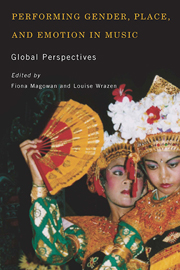Book contents
- Frontmatter
- Contents
- Acknowledgments
- Introduction: MusicalIntersections, Embodiments, and Emplacements
- Part One Landscope and Emotion
- Part Two Memory and Attachment
- 4 Christian Choral Singing in Aboriginal Australia: Gendered Absence, Emotion, and Place
- 5 Transforming the Singing Body: Exploring Musical Narratives of Gender and Place in EastBavaria
- 6 A Place of Her Own: GenderedSinging in Poland's Tatras
- Part Three Nationalism and Indigeneity
- Afterword
- Selected Bibliography
- List of Contributors
- Index
4 - Christian Choral Singing in Aboriginal Australia: Gendered Absence, Emotion, and Place
from Part Two - Memory and Attachment
Published online by Cambridge University Press: 05 December 2013
- Frontmatter
- Contents
- Acknowledgments
- Introduction: MusicalIntersections, Embodiments, and Emplacements
- Part One Landscope and Emotion
- Part Two Memory and Attachment
- 4 Christian Choral Singing in Aboriginal Australia: Gendered Absence, Emotion, and Place
- 5 Transforming the Singing Body: Exploring Musical Narratives of Gender and Place in EastBavaria
- 6 A Place of Her Own: GenderedSinging in Poland's Tatras
- Part Three Nationalism and Indigeneity
- Afterword
- Selected Bibliography
- List of Contributors
- Index
Summary
This chapter examines the relationships between choral singing, gender, and emotion in the Lutheran Australian Aboriginal community of Hopevale, northern Queensland (map 4.1). It is based on applied ethnomusicological research undertaken in collaboration with the Hopevale community between 2004 and 2005. During this period I worked as a choral music facilitator, conducting the Hopevale Community Choir (see fig. 4.1) and occasionally teaching music at the Hopevale state primary school. I developed an ethnographically informed approach to choral facilitation that incorporated Hopevalian understandings of musical preferences and performance aesthetics and what it means to “sing in a choir.” Through conducting, singing, and socializing with the Hopevale Community Choir, I began to question how emotional responses to choral singing in Hopevale are influenced by gender and place. In this chapter I explore whether contemporary Lutheran choral singing can strengthen the formation of a specifically Lutheran, Hopevalian identity or whether changes in musical preferences and the decline of active church-based Christian worship mean that hymnody is no longer as important in sustaining local identities as it once was.
In particular, I examine how the relative absence of young men from the community choir, and from the community more generally, can affect emotional responses to choral hymn singing of Hopevalian choral singers and choir audiences. I do so through an analysis of a performance given by the almost entirely female Hopevale Community Choir in the Lotus Glen men's correctional facility in Mareeba, northern Queensland.
- Type
- Chapter
- Information
- Performing Gender, Place, and Emotion in MusicGlobal Perspectives, pp. 85 - 108Publisher: Boydell & BrewerPrint publication year: 2013



